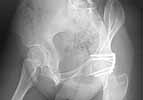


Date: Mon, 23 Aug 2004 23:32:00 +0200
Subject: Acetabular Fracture - Late Complaints
From: Victor de Ridder
I would like to present to you a case of a young woman (born 1976) with a acetabular fracture of the posterior wall. In first instant missed in another hospital, operated after 3 weeks in Januari 1997. Standard prone position KL approach, Ischial nerve was not involved as far as we could determine preop and perop. The Ischial nerve was observed, not extensively explored. Standard ORIF and postop mobilization without problems. Postop no neurological complaints and normal function and strength, followup in the other hospital. After 5 years suddenly pain in the trochanteric region, probably a bursitis trochanterica, nonoperative treatment with Lidocaine Kenacort injections. Radiolgy and bonescintigraphy showed no changes or hotspots, no signs of joint narrowing etc. After 2 injections the pain disappeared. Then fall/winter 2003-2004 she returned with pain higher in the buttock near the distal part of the SI joint same side as her acetabular fracture. Irritation of the M. piriformis was the first diagnosis. Exercises and change of work, no result. Orthopedic consult: no joint problems.
She returned to my outpatient clinic: pain buttock and slight radiation lateral side of the leg in certain positions of pelvis/leg. Cannot stand on her leg for long periods: 3-4 hr. then pain buttock and leg. Slight atrophy of the gluteal muscles (4+). Gross neurological research: no deficits, reflexes normal, can stand on her toes. Xray of the pelvis: no joint space narrowing.
Does anybody have a suggestion?? Ischiadic nerve neuropathy due to HO or scar tissue? CT scan in 1998 (1 year postop) showed no heterotopic ossifications, but is hard to read due to scatter.

| 
|  |
Thank you,
Victor de Ridder ( Westend Hospital, The Hague, Holland)
Date: Wed, 25 Aug 2004 08:56:33 -0700
From: Chip Routt
Look "upstream" to her spine and nerve roots.
Chip
Date: Wed, 25 Aug 2004 13:42:40 -0400
From: Bruce P. Meinhard
I would suggest an EMG and NCV to evaluate peripheral components of the sciatic nerve as well as a paraspinal survey, and a conduction velocity across the area involved in your surgical exposure.Also consider MRI of L/S spine. Scar and nerve entrapment is unusual at the operative site , but more commonly, pathology is located in the Lumbar spine.